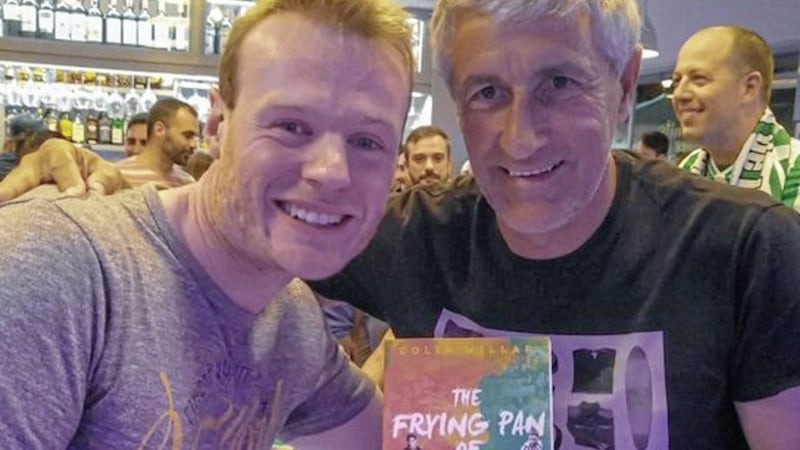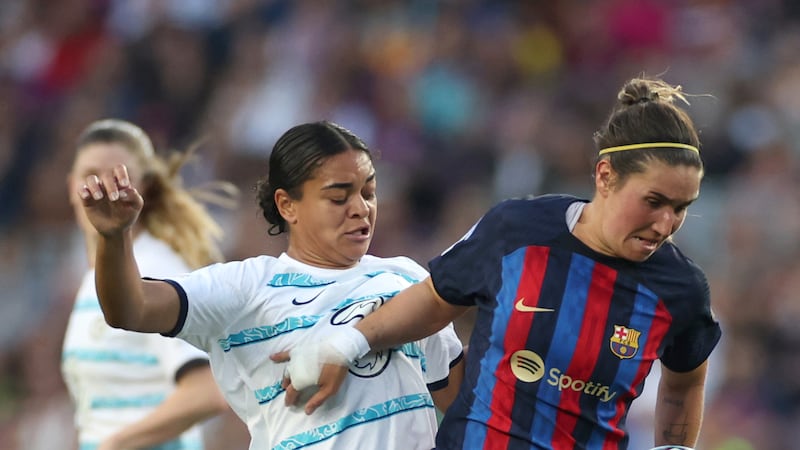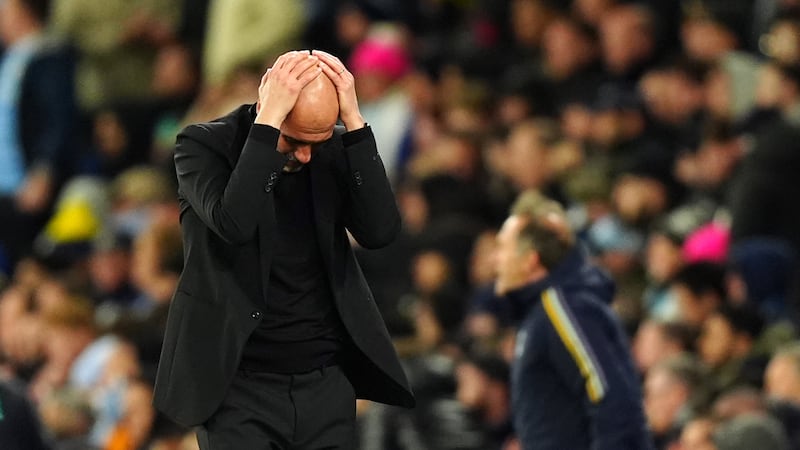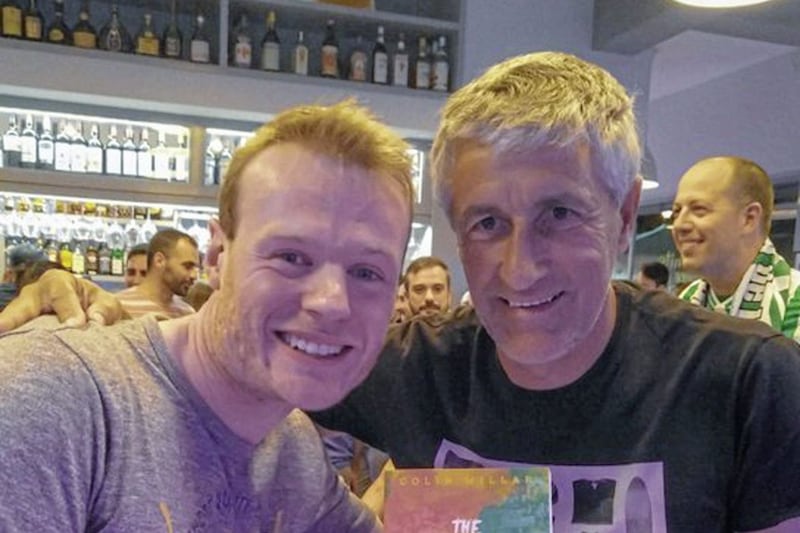DEBATES will always rage about which is football’s ‘greatest derby’ - but Belfast man Colin Millar has no doubt whatsoever.
Not Celtic-Rangers, not Liverpool-Everton, not even the Argentinian ‘SuperClasico’ between Boca Juniors and River Plate.
No, for Millar, there is nothing like the Seville derby, between Sevilla Futbol Club and Real Betis Balompie, so he’s written a book about it, entitled ‘The Frying Pan of Spain’.
Subtitled ‘Sevilla v Real Betis: Spain’s Hottest Football Rivalry’, the title is inspired by the heat of the Andalusia region but it might be said that the two clubs are like bacon and eggs, perhaps patatas bravas and chorizo, incomplete without each other.
“A lot of things struck me when I went to Seville,” recalls Millar: “the weather, and obviously it’s a fabulous city, but it’s impossible to over-state just how important and significant those two clubs are in terms of the city. Pretty much everyone I met had an affiliation to one or other.”
The relationship that sparked his interest didn’t last, but his love of Spanish football and the Seville clubs in particular has only grown. Now the editor of the Football Espana website, he says:
“I was lucky, I went out as a tourist a few times, then went out in 2014 for a couple of months – my girlfriend at the time was part of the Erasmus programme out there.
“At that time I wasn’t a particularly big fan of Spanish football; I’ve always covered football at a local level, but Spanish was never a passion of mine.
“I knew about Sevilla and what they’d done in the Europa League, but I started to realise that my knowledge of Spanish football, outside Barcelona and Real Madrid, was very low. There’s very little English coverage outside of those two clubs, which is kind of bizarre.”
Yet given the relative lack of success of Real Betis and Sevilla, perhaps their limited limelight is not so surprising.
The fact that they’ve each only won La Liga once apiece, and not since 1946, merely adds to the mystique of this rivalry.
The levels of support are extraordinary, says Millar: “[European football writer] Andy Brassell compared it to Newcastle and Sunderland being in one city, that’s essentially what this is, that fanaticism.
“Apart from the last 10 years for Sevilla, these two clubs have never really won anything. They’ve each won one league title – yet between them they have about 100,000 season ticket-holders, in a city of 700,000 people. That is insane.”
There’s a craziness to other derby rivalries, of course, but Millar discerns another difference: “It’s such a unique derby in that the fandom is so high but it’s also fuelled by being 50-50 and these two massive clubs are only about two miles apart. Families are split, rival fans get married.
“It’s genuinely 50-50 – I don’t think you can say that about any other city.”
Well, perhaps one – Glasgow – but Millar insists: “It’s quite distinct – the ‘Old Firm’, Celtic and Rangers in Glasgow, there’s a very clear divide. Most other derbies too there are geographical divides.
“That used to be the case, 50-60 years ago, Betis tended to be more working class, Sevilla the [well-to-do] ‘senorito’ culture as it were, not really the case anymore.”
Millar’s deep delve into the history of the city and its clubs makes for a fascinating read.
“I lived in Seville for 18 months, 2016 to early 2018, immersed myself in the rivalry and culture, and that made me want to learn more about why it is so big.”
Both clubs have historic Irish connections, with Betis’s green and white colours apparently modelled on Celtic, with stripes instead of the famous hoops.
Manuel Ramos Asencio, who captained Sevilla Balompie – a precursor club of Betis – had boarded at St Joseph’s College in Dumfries, Scotland, which was set up by Celtic founder Brother Walfrid. The story goes that Asencio picked up his love of football at Parkhead and brought their colours back to Andalusia (which also happens to have green and white as the colours of its flag).
Dubliner Patrick O’Connell, whose name has become famous in recent years for his association with Barcelan, bossed Betis to their only ever league title, and went on to manage Sevilla.
Sevilla’s first ever official manager, in a standalone manager role, not as a player-boss, was a certain Charles O’Hagan, from Buncrana in Donegal.
Although Sevilla says it’s Spain’s oldest club devoted solely to soccer (a claim disputed by Beticos, of course), Betis won La Liga first, in 1935-36, under O’Connell – then promptly declined.
Betis had just signed off on a massive land deal before the Spanish Civil War broke out. Seville became the first big city to fall to the right-wing Nationalist/ military coup, and a Betis team built on Basque players fell apart.
Indeed Betis fell so hard that they spent more than a decade in the third division – yet that trauma contributed to their huge support.
“They took the game to the pueblos, small towns and villages in Andalusia, gained mass support, while half of Sevilla’s games were at the other end of the country.”
That continues to this day, with Betis having the bigger support, despite being far less successful than Sevilla recently, with the latter winning five Europa Leagues from 2006 to 2016.
“It doesn’t make sense why Betis is so big. Everyone assumes that Sevilla is the bigger club but that’s not the case.”
Indeed Betis has the fourth biggest support in all of Spain, behind the big two of Barcelona and Real Madrid, and Atletico Madrid.
Sevilla are well backed too, however: “In every other Spanish city it seems like everyone supports [Real] Madrid or Barcelona and then support their local team too.
“I lived in Vigo, Galicia and there are more people in bars to watch Real Madrid matches than there were to watch Celta Vigo away games. There’s a 15-16,000 fan-base there, it’s a big problem for Spanish football
“Seville is different, there are kids in Sevilla or Betis tops everywhere; in other cities that’s not the case.”
So Seville and its soccer rivalry is special. Millar suggests that football fans should see it for themselves, even though there’s a risk attached to that:
“Everything is about these clubs and this derby. What sets it apart from other rivalries, Barca-Real [Madrid], [Manchester] United-Liverpool, is there aren’t really tourists. With those clubs, with their global fan-bases, the match-day experiences are getting watered down, it’s not the authenticity you’re thinking of.
“The Seville clubs are [authentic]. I don’t know if that will last forever, but right now it is. I would implore anyone to go to the city and take in the derby. I’ve been to a lot of matches, a lot of derbies, but nothing is comparable.”
Ironically, both clubs have tried, and continue to try, to widen their appeal.
Sevilla signed Diego Maradona in 1992 after he served a 15-month ban for cocaine use, attracted to Andalusia by his former Argentina boss Carlos Bilardo.
Millar devotes an entire chapter to this, commenting: “This was a ‘statement signing’, designed to put them on the map – it’s very difficult for them to do that, even though, I keep stressing, these two clubs are genuinely huge.”
In 1998, Betis president Manuel Ruiz de Lopera broke the world transfer record for 20-year-old Brazilian Denilson, outbidding Barcelona, Real Madrid, and Manchester United. The 19-year-old signed an 11-year contract with a reported release clause of £261m.
By the end of the next season Betis had been relegated.
“Betis had no need to spend that much, the owner wanted to say ‘We are a global club’ and ‘I’m the most important person in Seville’.
By the time Betis got promoted, reached the Champions League, and won the Copa del Rey [in 2005], Denilson was merely a fringe player. He was sold to Bordeaux that summer – for an undisclosed sum.
“There’s a sense of narcissism about the place and the people, they know that Seville is such an amazing city, know they come from this wonderful place, that attaches to their idea maybe not of themselves but of their clubs, they want to out-do the other constantly.”
It’s the supporters, the supporting in Seville, that Millar always returns to, is drawn to: “In this derby, fans are so strongly attached to their clubs. It’s not just the 90 minutes, they go to training sessions in their tens of thousands, they go to the team hotel to cheer them off.
“You’re not just a Sevilla fan or a Betis fan, you’re a Sevillista or a Betico, that is the core of their fandom.
“Take it back to the Glasgow derby, people are sort of born into it. It’s similar in Northern Ireland, you’re streamed down one half or the other.
“But in Seville, especially, people are shaped by the club that they support. What does it embody to be a supporter of that club? I think it’s different in that way.
“They don’t see themselves as different because of coming from a different background but due to a different idea of what fandom is.
“The whole ‘Betis manqué pierda’ thing – ‘We support them when they lose’ – that’s been there for decades and is still prevalent: 60,000 fans at every match and they’re probably not going to win a thing for another decade. That’s the mentality.”
He concludes with a contradiction, a call to see a wonder of the world while perhaps contributing to its demise:
“Say they attract massive numbers of fans in next few years, will the incredible atmosphere be lost? There’s an inevitable compromise between football tourists and season ticket-holders. The atmosphere might not last forever but for now it’s special
“Football is becoming very sanitised, and you have to jump through hoops to get match tickets [for major clubs] - this is an experience, people should take advantage while they still can”.
* ‘The Frying Pan of Spain’ by Colin Millar is published by Pitch Publishing, priced £12.99.



